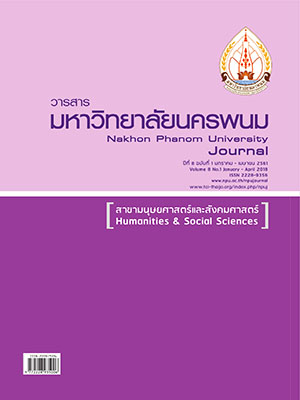ตัวบ่งชี้ภาวะผู้นำเชิงคุณธรรมสำหรับผู้บริหารสถานศึกษาขั้นพื้นฐาน: โมเดลความสัมพันธ์เชิงโครงสร้าง
Main Article Content
Abstract
บทคัดย่อ
การวิจัยนี้มีจุดมุ่งหมายเพื่อพัฒนาโมเดลความสัมพันธ์เชิงโครงสร้างตัวบ่งชี้ภาวะผู้นำเชิงคุณธรรมสำหรับผู้บริหารสถานศึกษาที่ขั้นพื้นฐาน โดยมีวัตถุประสงค์ดังนี้ 1) ศึกษาความเหมาะสมของตัวบ่งชี้เพื่อคัดสรรไว้ในโมเดล 2)ทดสอบความสอดคล้องของโมเดลที่พัฒนาขึ้นจากทฤษฎีและผลงานวิจัยกับข้อมูลเชิงประจักษ์ และ 3) ตรวจสอบค่าน้ำหนักองค์ประกอบขององค์ประกอบหลัก องค์ประกอบย่อย และตัวบ่งชี้ โดยระเบียบวิธีวิจัยเชิงบรรยาย กำหนดขนาดกลุ่มตัวอย่างโดยใช้กฎอัตราส่วนระหว่างหน่วยตัวอย่างต่อจำนวนพารามิเตอร์ 20:1 จากพารามิเตอร์จำนวน 37 พารามิเตอร์ ได้กลุ่มตัวอย่าง 740 คนจากประชากรที่เป็นผู้บริหารสถานศึกษา 30,719 คนเก็บข้อมูลจากกลุ่มตัวอย่างที่ได้มาโดยวิธีการสุ่มแบบหลายขั้นตอน โดยใช้แบบสอบถามเป็นมาตรวัดแบบประเมินค่า 5 ระดับ ที่มีค่าความเชื่อมั่น 0.874 วิเคราะห์ข้อมูลโดยโปรแกรมสำเร็จรูปทางสถิติและโปรแกรมลิสเรลผลการวิจัยเป็นไปตามสมมุติฐานการวิจัย คือ (1) ตัวบ่งชี้มีความเหมาะสมได้รับการคัดสรรไว้ในโมเดลทุกตัว โดยมีค่าเฉลี่ยเท่ากับหรือสูงกว่า 3.00 และมีค่าสัมประสิทธิ์การกระจายเท่ากับหรือต่ำกว่า 20% (2) โมเดลมีความสอดคล้องกับข้อมูลเชิงประจักษ์ดีมาก พิจารณาจากค่าไค-สแควร์(c2 ) เท่ากับ 13.07 ค่าองศาอิสระ (df) เท่ากับ 12 ค่านัยสำคัญทางสถิติ (p-value) เท่ากับ 0.36417 ค่าดัชนีวัดระดับความสอดคล้อง (GFI) เท่ากับ 1.00 และค่าดัชนีวัดระดับความสอดคล้องที่ปรับแก้แล้ว (AGFI) เท่ากับ 0.970 และค่าความคลาดเคลื่อนในการประมาณค่าพารามิเตอร์ (RMSEA) เท่ากับ 0.012และ (3) องค์ประกอบหลักทุกตัวมีค่าน้ำหนักองค์ประกอบสูงกว่าเกณฑ์ 0.70 องค์ประกอบย่อยและตัวบ่งชี้ทุกตัวมีค่าน้ำหนักองค์ประกอบสูงกว่าเกณฑ์ 0.30
Abstract
This research aims to develop a structural relationship model of indicators of moral leadership for administrators in basic education schools. The purposes are as follows 1) to study the appropriateness of indicators for selection in the model, 2) to test the congruence of the model developed from theory and research with empirical data, and 3) to investigate the factorloading of major factors, sub-factors, and indicators. Using the descriptive research methodology. The sample size was determined by using the ratio rule between the unit of sample and the amount of parameter 20: 1. From 37 parameters got 740 samples from the 30,719 school principals. Collecting datafrom the samples selected by Multi-stage Random Sampling by using the 5 level rating scale questionnaire with reliability coefficient 0.8740. Data were analyzed by using descriptive statistic, and inferential statistic by statistical program and LISREL Program. Research results were based on the research hypotheses that (1) All indicators were appropriate to be selected in the model, as the mean was equal to or higher than 3.00 and had a distribution coefficient equal to or less than 20%. (2) The model was congruent with the empirical data very well. Considering the Chi-Square Statistics(c2) was13.07, the degrees of freedom (df) was 12,the statistically significant (p-value) was 0.36417,the Goodness of Fit Index(GFI) was 1.00 and Adjusted Goodness of Fit Index(AGFI) was 0.970 and the Root Mean Square Error of Approximation(RMSEA) was 0.012; and (3) All major factors had a factor loading value higher than 0.70, all sub-factors, and all indicators had a factor loading value higher than 0.30.
Article Details
References
เจือจันทร์ จงสถิตอยู่ และแสวง ปิ่นมณี.(2529).ดัชนีทางการศึกษา.พิมพ์ครั้งที่ 2. กรุงเทพฯ: โรงพิมพ์องค์การสงเคราะห์ทหารผ่านศึก.
นงลักษณ์ วิรัชชัย. (2545). การพัฒนาตัวบ่งชี้สำหรับการประเมินคุณภาพการบริหารและการจัดการเขตพื้นที่การศึกษา. กรุงเทพฯ: ธารอักษร.
ปองภพ ภูจอมจิตร. (2557). การพัฒนาตัวบ่งชี้ภาวะผู้นำแบบใฝ่บริการของผู้บริหารสถานศึกษาขั้นพื้นฐาน.วิทยานิพนธ์ ครุศาสตร์ดุษฏีบัณฑิต สาขาการบริหารจัดการการศึกษาบัณฑิตวิทยาลัย มหาวิทยาลัยราชภัฏมหาสารคาม.
วิโรจน์ สารรัตนะ.(2558).การวิจัยทางการบริหารการศึกษา: แนวคิด แนวปฏิบัติและกรณีศึกษา. พิมพ์ครั้งที่ 4. (E-book) กรุงเทพฯ: ทิพยวิสุทธิ์.
ศูนย์ปฏิบัติการสังกัดสำนักงานคณะกรรมการการศึกษาขั้นพื้นฐาน. (2558). ข้อมูลจำนวนผู้บริหารสถานศึกษาขั้นพื้นฐาน. ค้นเมื่อ 1กันยายน 2558, จาก http://doc.obec.go.th/download_form/insert_data.php.
สุเทพ ปาลสาร. (2555). การพัฒนาตัวบ่งชี้ภาวะผู้นำเชิงจริยธรรมของผู้บริหารสถานศึกษา สังกัดสำนักงานคณะกรรมการการศึกษาขั้นพื้นฐาน. วิทยานิพนธ์ ปรัชญาดุษฏีบัณฑิต สาขาวิชาการบริหารการศึกษา บัณฑิตวิทยาลัย มหาวิทยาลัยขอนแก่น.
สำนักงานคณะกรรมการการศึกษาขั้นพื้นฐาน.
(2553).คู่มือการประเมินสมรรถนะผู้บริหารสถานศึกษา (ฉบับปรับปรุง พ.ศ. 2553). ค้นเมื่อ 5 สิงหาคม 2558, จาก http://www.kroobannok.com/27638
_________. (2560). UTQ – 55215 จริยธรรมสำหรับผู้บริหาร. ค้นเมื่อ 5 สิงหาคม 2558, จาก http://www.kroobannok.com/27638
สำนักงานคณะกรรมการข้าราชการพลเรือน. (2555). ชุดฝึกอบรมหลักสูตรการพัฒนาคุณธรรม. เอกสารประกอบการบรรยาย การฝึกอบรมหลักสูตรการพัฒนาคุณธรรม จริยธรรม สำหรับผู้บริหาร: ภาวะผู้นำเชิงจริยธรรม.
_________. (2559). หลักธรรมาภิบาลของการบริหารกิจการบ้านเมืองที่ดี. กรุงเพทฯ: วสุนธรา (สลธ.).
สำนักงานรัฐมนตรี. (2553). ครม.เห็นชอบแผนการศึกษาแห่งชาติ ฉบับปรับปรุง (พ.ศ. 2552–2559). ค้นเมื่อ 20 สิงหาคม 2558, จาก http://www.moe.go.th/websm/2010/jan/003.html.
Burns, J.M. (1978). Leadership. New York: Harper and Row.
Cole, G.A. (2002). Personnel and human resources management. 5th ed.,London: Book-Power.
Covey , S.R..(1991). Principle-centered leadership. Great Britain: The Bath Press.
Draft , R.L. (2001). The leadership experience. New York: Harcourt College Publishers.
Fullan, M. (2003).The moral imperative of school leadership. Thousand Oaks, CA: Crowin Press. Moriarty.
Gardner, H. (1987). Theory of multiple intelligences. Retrieved October 10,2015, from http://www.pirun.ku.ac.th/
Gold, R.Z. (1980). Introduction to bivariate and multivariable analysis. Illinois: Scott, Forman.
John, W. (1992). Organizational culture and leadership. San Francisco: Jossey –Bass Published.
Kerlinger, F.N; & Lee, H.B. (2000). Foundations of behavioral research. 4th edition. Belmont, California: Wadsworth Publishing.
Kohlberg, L.(1981).State and sequence: The cognitive-development approach to socialization. In D. Goslin(Ed.), Handbook of socialization theory and research (pp.347?480).Chicago: Rand McNally.
Moorhouse, J.(2002). Comparative analysis of
leadership perceptions: study in USA. Tennessee: East Tennessee State University.
National Policy Board for Educational Administration.(2004). Professional
standards for educational leaders. Retrieved October 10,2015, from http://marylandpublicschools.org/about/Pages/OTPE/PSEL.aspx
Paul, J.H. (2013). Strategic leadership: The essential skills. Harvard Business Review. January/February 2013.
Pellicer, L.O. (2003). Caring enough to lead: how reflective thought leads to moral leadership. Thousand Oaks, CA: Crowin Press.
Sergiovanni, Thomas J. (1992). Moral leadership: Getting to the heart of school leadership. San Francisco: Jossey Bass.

